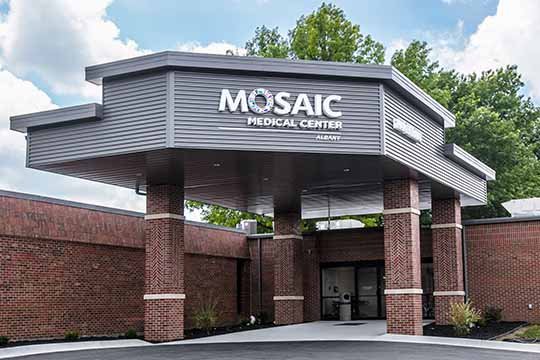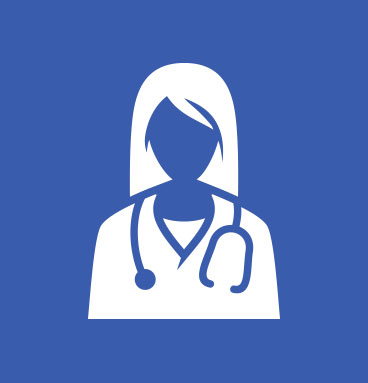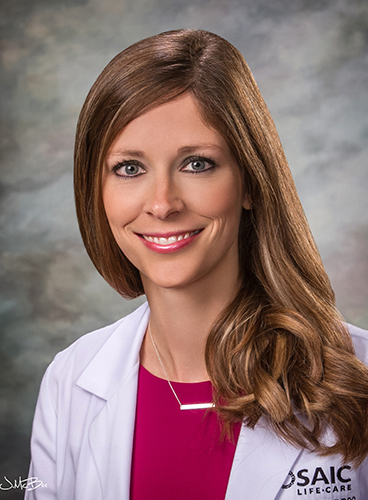Contact Us
For an appointment in St. Joseph, please call:
- Mammography at (816) 271-1278
- Radiology and Outpatient Imaging at (816) 671-4846.
For an appointment in Maryville, please call (660) 562-7907.
For an appointment in Albany, please call (660) 726-1226.
Getting a regular mammogram is widely agreed upon as the best practice for breast care. Mammography is the most accurate diagnostic technique available to early detection of breast disease. At Mosaic Life Care’s Breast Care Centers in St. Joseph, we use two types of mammography procedures: screening mammography and diagnostic mammography.
Screening mammography is an X-ray examination of the breast in a woman who is asymptomatic (has no breast complaints). The goal of screening mammography is to detect cancer when it is still too small to be felt by her physician or the woman. Early detection of small breast cancers by screening mammography greatly improves a woman's chance for successful treatment. Screening mammography usually involves two views (X-ray pictures) of each breast. For some patients, additional pictures may be needed at screening to include as much breast tissue as possible.
Diagnostic mammography is an X-ray examination of the breast in a woman who either has a breast complaint (for example, a breast mass, nipple discharge, etc.) or has had an abnormality found during screening mammography. During diagnostic mammography, additional pictures will be taken to carefully evaluate the breast abnormality.
The American Cancer Society guidelines for the detection of breast cancer in asymptomatic women are:
- Women 20 years of age and older should perform breast self-examination every month.
- Women 20-39 should have a physical examination of the breast every three years, performed by a health care professional such as a physician, physician assistant, nurse or nurse practitioner.
- Women 40 and older should have a physical examination of the breast every year, performed by a health care professional, such as a physician, physician assistant, nurse or nurse practitioner.
- Women 40 years of age and older should have a mammogram every year.
We encourage you discuss your screening mammography procedure with your physician, however, physician referral is not required. Appointments may be scheduled by your physician or directly by calling (816) 271-1278.
Mosaic Life Care offers Tomosynthesis (3D) Mammography, one of the most advanced breast cancer technologies available today. The new technology is FDA-approved and gives women a choice as to what type of mammogram they have.
What is contrast-enhanced mammography (CEM)?
Contrast-enhanced mammography (CEM) is an advanced type of breast imaging. It uses a standard mammogram along with a special dye (called contrast) that’s injected into your arm through an IV. The dye contains iodine, like what’s used in CT scans, and helps highlight areas in the breast that may be hard to see on regular mammograms.
How does CEM help detect cancer?
Breast cancers often grow new blood vessels to feed the tumor. These blood vessels are abnormal and tend to leak the contrast dye. When the dye builds up in those areas, it becomes easier to spot tumors on the X-ray images. This helps doctors find cancer that might be hidden on a regular mammogram — especially in women with dense breast tissue.
How is CEM different from a regular mammogram?
The biggest difference is the contrast dye. With CEM, a small IV is placed in your arm to give the contrast before your images are taken. After that, the process is like a regular mammogram. CEM is a 2D mammogram, so you would still need to do your yearly 3D screening mammogram. The contrast highlights areas of increased blood flow, making cancer stand out more clearly.
Why is CEM better for women with dense breasts?
Dense breast tissue can make it hard to see cancer on a regular mammogram because both appear white on the image. CEM overcomes this problem. The contrast dye lights up areas with more blood flow (like tumors), helping doctors see cancers that might be hidden in dense tissue.
What are the advantages of CEM?
- Better cancer detection in dense breast tissue.
- Less expensive and more accessible than MRI.
- More comfortable for many patients (no tight spaces like an MRI machine).
- Detailed images — similar in quality to MRI, but with fewer downsides.
When is CEM used?
Advanced Practice Providers may use CEM to:
- Check the size or spread of cancer after a new diagnosis.
- See how a cancer is responding to chemotherapy before surgery.
- Investigate breast symptoms or unclear areas seen on a regular mammogram.
- Evaluate dense breast tissue and high-risk patients.
Is CEM approved and safe?
Yes. CEM is FDA-approved for diagnostic use and has been shown to be safe and effective. It’s a trusted tool for evaluating breast cancer and other breast concerns.
Is CEM used for breast cancer screening?
CEM is currently being studied as a screening tool, especially for women with dense breasts. Studies show it can find about 10 cancers for every 1,000 women screened — even when their regular mammogram looks normal. This is about the same as MRI performance.
Where can I get a CEM exam?
Mosaic Life Care now offers CEM. This powerful imaging option can help detect breast cancer earlier and more clearly — especially for women with dense breast tissue.
Do I need a referral?
Yes. CEM is available by provider referral only. Talk to your doctor to find out if this test is right for you.
Mosaic Life Care offers Tomosynthesis (3D) Mammography, one of the most advanced breast cancer technologies available today. The new technology is FDA-approved and gives women a choice as to what type of mammogram they have.
What should I expect during my tomosynthesis 3D exam?
The tomosynthesis exam is very similar to having a conventional two-dimensional mammogram. Like a two-dimensional mammogram, the technologist will position you, compress your breast and take images from different angles. There’s no additional compression required with a tomosynthesis exam and it only takes a few seconds longer for each view. The technologist will view the images of your breasts at the computer workstation to ensure quality images have been captured for review. A radiologist will then examine the images and report results to either your physician or directly to you.
Who can have a tomosynthesis 3D exam?
A tomosynthesis exam is approved for all women who would undergo a standard two-dimensional mammogram. Multiple clinical studies show that all women, regardless of breast type or density, benefit from a tomosynthesis exam.
Why choose a tomosynthesis 3D exam?
A tomosynthesis exam detects 41 percent more invasive breast cancers and reduces false positives by up to 40 percent. This means one simple thing: more accuracy. The exam allows doctors to see masses and distortions associated with cancers significantly more clearly than conventional two-dimensional mammography. Instead of viewing all of the complexities of your breast tissue in a flat image, as with conventional two-dimensional mammography, fine details are more visible and no longer hidden by the tissue above or below.


























